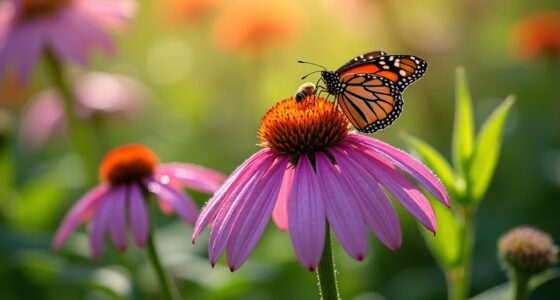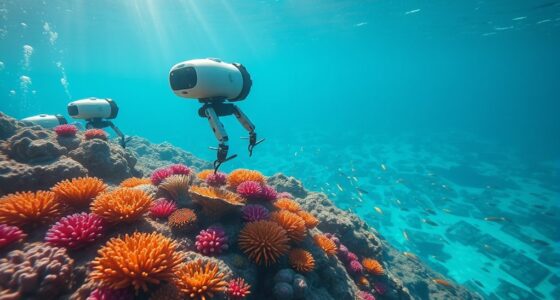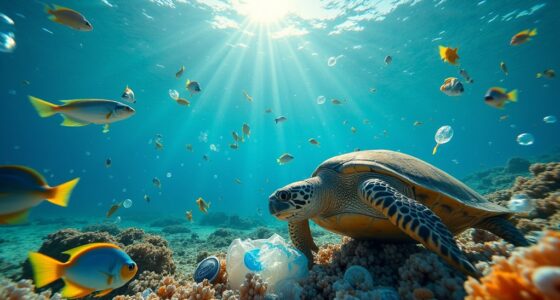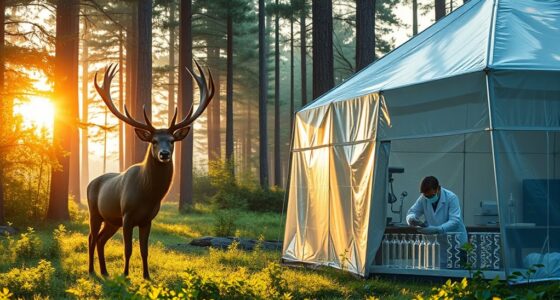Protecting wildlife and their habitats is vital because it supports healthy ecosystems and helps endangered species survive. When you protect natural environments like forests and wetlands, you preserve biodiversity and create safe refuges for animals to thrive and reproduce. Reducing threats like pollution, deforestation, and climate change also strengthens these ecosystems. Your actions can make a difference, and if you explore further, you’ll discover how everyone can help sustain our planet’s vibrant wildlife now and in the future.
Key Takeaways
- Preserving habitats ensures the survival of endangered species and maintains ecological balance.
- Protecting wildlife safeguards biodiversity, which benefits the health of the entire planet.
- Habitat loss from threats like deforestation and pollution increases extinction risks for vulnerable animals.
- Conservation efforts help create safe environments for species to thrive and reproduce naturally.
- Maintaining healthy ecosystems supports resilience against environmental threats and benefits future generations.

Have you ever wondered why protecting wildlife matters? It’s because the survival of countless species depends on our actions, and one of the most essential ways to support them is through habitat preservation. When you think about it, animals rely on natural environments—forests, wetlands, grasslands—to find food, reproduce, and thrive. If these habitats are destroyed or degraded, the animals that depend on them face a grim future. Habitat preservation isn’t just about saving pretty scenery; it’s about maintaining the delicate balance that keeps ecosystems healthy and productive. When habitats are intact, endangered species have a fighting chance to recover and flourish. Without a safe place to live, even the most resilient animals can become endangered or extinct, which would cause irreversible damage to the ecological web.
Protecting natural habitats is vital for wildlife survival and ecosystem health.
Protecting wildlife isn’t just about saving individual animals; it’s about safeguarding biodiversity, which benefits everyone. When a species becomes endangered, it signals that something’s wrong with the environment—whether it’s pollution, deforestation, climate change, or illegal poaching. By focusing on habitat preservation, you help create safe spaces where endangered species can find refuge and reproduce naturally. This effort reduces the risk of extinction for these vulnerable creatures. For example, preserving forests not only benefits the iconic Bengal tiger but also supports countless other species that share the same habitat. When habitats are protected, the entire ecosystem benefits, making it more resilient against environmental threats. Additionally, resources and tools available to support conservation efforts can greatly enhance the effectiveness of these initiatives.
Taking action to protect wildlife is a responsibility that falls on everyone, from governments and organizations to individuals like you. Simple steps such as supporting conservation projects, reducing your carbon footprint, and advocating for policy changes can make a real difference. You can also participate in local efforts to preserve green spaces or volunteer with organizations dedicated to wildlife protection. Each action contributes to a larger movement that emphasizes habitat preservation as a cornerstone of conservation. When you invest in protecting the natural environments where animals live, you’re actively helping prevent the decline of endangered species and ensuring that future generations can enjoy the richness of our planet’s biodiversity.
In the end, wildlife conservation isn’t just about saving animals—it’s about maintaining the health of the entire planet. By understanding the importance of habitat preservation, you recognize your role in supporting endangered species and ensuring that natural ecosystems continue to thrive. Your choices and actions today can help create a future where wildlife is protected, ecosystems are balanced, and the beauty of our natural world endures.
Frequently Asked Questions
How Can Individuals Contribute to Wildlife Conservation Efforts?
You can contribute to wildlife conservation by getting involved in your community through local conservation projects or volunteering. Practice sustainable habits like reducing plastic use, conserving water, and supporting eco-friendly products. Educate others about the importance of protecting animals and their habitats. Your efforts make a difference, and when many adopt sustainable practices and community involvement, it creates a powerful collective impact on preserving wildlife for future generations.
What Are the Most Critically Endangered Species Today?
Think of the world’s endangered species as fragile glass ornaments, easily shattered. Today, critically endangered species like the vaquita, Javan rhino, and Sumatran orangutan face the threat of extinction. These endangered species demand urgent attention, making them top conservation priorities. By supporting efforts to protect their habitats and combat threats like poaching, you help guarantee these essential creatures don’t vanish forever, preserving biodiversity for future generations.
How Does Habitat Loss Impact Global Biodiversity?
Habitat loss from urban encroachment and agricultural expansion directly reduces biodiversity by destroying natural homes for many species. You see, when forests, wetlands, and grasslands shrink, animals lose their shelter, food sources, and breeding grounds. This decline causes species to become endangered or extinct. By understanding this, you realize how vital it is to balance development with conservation efforts to protect our planet’s rich biodiversity and guarantee healthy ecosystems.
What Legal Protections Exist for Endangered Animals?
Imagine endangered species as fragile glass sculptures—you’d want to protect them at all costs. Legal frameworks like the Endangered Species Act and CITES provide essential protections, making it illegal to hunt, trade, or harm these animals. These laws help guarantee that endangered species, from elephants to tigers, survive and thrive. By knowing and supporting these laws, you actively contribute to safeguarding our planet’s precious biodiversity.
How Do Climate Change and Wildlife Conservation Interconnect?
You see, climate change and wildlife conservation are deeply connected. As climate change causes shifts in habitats, animals struggle to adapt, making climate adaptation efforts essential. Your actions, like reducing your carbon footprint, help slow climate change and protect vulnerable species. By supporting conservation initiatives, you help create resilient ecosystems where animals can survive and thrive despite changing environmental conditions. This interconnected effort benefits both wildlife and our planet’s future.
Conclusion
By now, you see why protecting animals is essential, like tending a delicate garden that keeps our planet thriving. Every effort you make, whether it’s supporting conservation programs or spreading awareness, helps preserve the incredible diversity of wildlife. Remember, your actions matter more than you think—they’re the backbone of a healthier Earth. Together, we can create a future where animals flourish, just like a vibrant, unstoppable river flowing endlessly towards hope.










